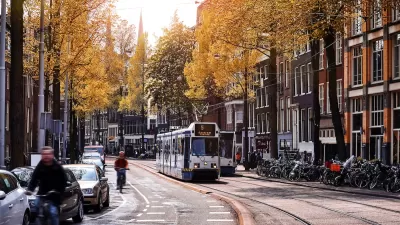In its most forward attempt to ensnare the fabled “discretionary rider,” my local transit agency recently set out handsome billboards touting the pleasures of the bus and the miseries of driving alone. They employed pithy admonishments and graphics such as a hand cuffed to a gas pump and a merry executive knitting and purling his way to the office.
In its most forward attempt to ensnare the fabled "discretionary rider," my local transit agency recently set out handsome billboards touting the pleasures of the bus and the miseries of driving alone. They employed pithy admonishments and graphics such as a hand cuffed to a gas pump and a merry executive knitting and purling his way to the office.
As a loyal customer of said agency, I sent some slogans of my own to a friend who works in the PR department. The first, and best, was, "You're not in traffic. You are traffic." Another, "If you're driving your car, then who's driving this bus?" And, perhaps too bluntly, "If you're not part of the solution, you're part of the problem." Each would come with a photo of the gnarliest traffic jam this side of Bangkok and precede the agency's omnipresent slogan, "Go Metro."
I suspect that my ads didn't go into service because they share an objectionable tone (snideness) and a theme that is, in most public circles, unspeakable: the problem of collective action.
Planning -- both land use and transportation -- has progressed mightily since the days when Benthamite visionaries or political heavies would plat a city and expect the populace to fall obediently into place. But for all the recent talk of human-centered planning, a chasm still separates the built environment from the instincts of the popular swarm. Plans, whether in land use or transportation, still rest on the mere assumption that people will actually sit on plaza benches, fly a kite in the park, and, of course, ride the bus.
But the fate of American urbanism should not rest on passive hopes. The problem of collective action -- in which individual choices ignore the public good and selfishness amounts a betrayal of both one's neighors and oneself -- poses the most powerful threat to even the best of plans. If behavior does not change, then all the walkability, efficiency, and quaintness in the world will differ little from a Corbusian superblock.
In architecture, the subjectivity of aesthetics blends with the objectivity of function to the point that it nearly transcends evaluation. But planning operates squarely at the intersection of social science and real life. It intends to change human behavior, or at least enhance its best tendencies. If it does not do so, it fails. But failure that stems from misunderstanding is different -- and perhaps worse -- than failure from a flawed plan. In short, planning cannot speak through plans alone. Yet few, if any, planners (and I count the public officials and politicians as planners, regardless of technical skill) ever speak of what people should do. But I can't imagine how you could kill a collective action problem without naming it as such.
Maybe these topics come up in planning school, and certainly they are implicit in any well intentioned set of drawings. But as a journalist, I've conducted countless interviews and endured an equal number of speeches, and none has ever assigned the burden of improving the public sphere to the public itself. None has tried to inspire people to act the way the plans want them to. (Though I seem to remember a certain dashing president say something about that once, but that was long ago, and perhaps he was too eloquent for anyone else to bother following suit.) Were it not for my obligation to objectivity, I would have long ago tried to pry such a sentiment out of their mouths.
As traffic here in Los Angeles thickens by the day, city leaders often cite their favorite statistic from the world of traffic engineering: the free flow of traffic requires only a five percent reduction in the volume thereof. No plan, highway, bus lane, or subway ever could be as elegant as that. But as many times as I've heard the claim, I have never heard anyone mention the next step: Where is that five percent going to come from?
Obviously it can, and should, come from radical behaviors like carpooling, discretionary transit ridership, walking, biking, and even deliberate efforts to live closer to work -- in other words, from things that have nothing to do with infrastructure or planning and everything to do with personal decisions. Do only that, and everyone moves faster. Yet we would usually rather build a new superhighway than try to influence those decisions for free.
The reluctance to confront the idiocy of the collective hardly belongs to planning alone. Its long history stems from one of the more unfortunate contradictions in American culture. American tradition exalts both pragmatism and freedom, but all too often, freedom -- which, of course, includes the freedom to make lousy choices -- prevails at pragmatism's expense. Herein lies the implication that compulsory carpooling would be downright un-American.
But which is more free: The freedom to decompose in rush hour traffic? The freedom to spend $1 billion in tax money on one ten-mile lane of freeway? The freedom to gobble up a half acre for your trampoline, barbecue grill, quoits pit? The freedom to partake of the collective good -- or the freedom to subvert it? Ironically, the same factions that object to governmental impositions on, say, driving are the very same factions that demand that government build them new roads.
Americana fails to realize that freedom cannot be granted; it can only be limited. (As Jane Jacobs wrote of poverty, freedom "has no causes.") Any civilization, even one as magnificently flawed as ours, confers only choices among constraints -- and among agents to impose them, whether they be the government, our neighbors, or our own selves. We willingly suffer constraints every day, and we accept many that bear only arbitrary distinctions from those we consider odious. We accept taxes, compulsory education, conscription, and speed limits because at some point someone convinced us of their necessity. But other would-be violations of liberty are to us like water to fishes.
Perhaps none is, by its very nature, more palpable, yet less apparent, than the interstices that abut the built environment. Despite its eternal, immutable presence, the constraints of the public realm, whether hewn by accident or design, never enters the public discussion. Laws requiring carpooling or a daily mile-long stroll would differ little in substance from those prohibiting smoking or calling for the surrender of 30 percent of our income, but no one has the courage to suggest them because we, paradoxically, fail to realize that our environment is, to a large degree, a product of our actions.
Somewhere amid gentle nudges, financial incentives, and threats of police power, planners must have enough respect for their craft and love for their cities to convince people that, for instance, $750 million could be better spent on incentives to carpool than on concrete, dust, and takings through eminent domain. (Divide that amount by 200,000 cars and we could pay everyone who commutes daily on the 405 $400 a year for ten years just to carpool once a month.) Take it from there, and we could reduce traffic, create critical masses pedestrians, and boost sales at local stores on Main Street if only we said that's what we wanted people to do.
Planning does not need to engage in manipulative public relations campaigns or make any promises it cannot keep. Deception is not freedom. But it should promote real analysis and real options -- freeway vs. bus; townhouse vs. sprawl; common good vs. selfishness. It should remind people of what they can want when options aren't taken away, and then let them choose. Companies spend millions to convince consumers to spend billions on their goods; surely the chance not to spend billions, and not to defile cities, is worth at least as vigorous a pitch.
Planning can confer on us real liberty -- the kind that doesn't stem from blind nationalism or marketing campaigns. Once we have it, we need only decide which freedoms to keep, which to forego, and which to churn into asphalt.

Planetizen Federal Action Tracker
A weekly monitor of how Trump’s orders and actions are impacting planners and planning in America.

Map: Where Senate Republicans Want to Sell Your Public Lands
For public land advocates, the Senate Republicans’ proposal to sell millions of acres of public land in the West is “the biggest fight of their careers.”

Restaurant Patios Were a Pandemic Win — Why Were They so Hard to Keep?
Social distancing requirements and changes in travel patterns prompted cities to pilot new uses for street and sidewalk space. Then it got complicated.

Platform Pilsner: Vancouver Transit Agency Releases... a Beer?
TransLink will receive a portion of every sale of the four-pack.

Toronto Weighs Cheaper Transit, Parking Hikes for Major Events
Special event rates would take effect during large festivals, sports games and concerts to ‘discourage driving, manage congestion and free up space for transit.”

Berlin to Consider Car-Free Zone Larger Than Manhattan
The area bound by the 22-mile Ringbahn would still allow 12 uses of a private automobile per year per person, and several other exemptions.
Urban Design for Planners 1: Software Tools
This six-course series explores essential urban design concepts using open source software and equips planners with the tools they need to participate fully in the urban design process.
Planning for Universal Design
Learn the tools for implementing Universal Design in planning regulations.
Heyer Gruel & Associates PA
JM Goldson LLC
Custer County Colorado
City of Camden Redevelopment Agency
City of Astoria
Transportation Research & Education Center (TREC) at Portland State University
Camden Redevelopment Agency
City of Claremont
Municipality of Princeton (NJ)






























